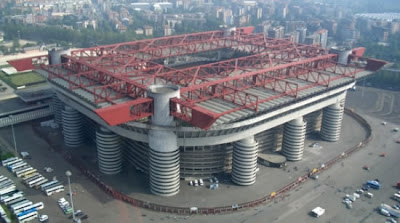The Stadio Giuseppe Meazza, commonly known as San Siro, is a football stadium located in the San Siro district in Milan, Italy. It is the home of both Associazione Calcio Milan and Football Club Internazionale Milano. On 3 March 1980,[2] the stadium was named in honour of Giuseppe Meazza, the two-time World Cup winner (1934, 1938) who played for Internazionale, and briefly for Milan, in the 1930s and 1940s. It held UEFA five-star stadium status which was superseded by a new system of classification.
As well as being used by Milan and Inter, the Italian national team also plays occasional games there and it has also been used for the 1965, 1970, and 2001 UEFA Champions League finals. The stadium was also used for Internazionale's UEFA Cup finals when played over home and away legs but has never featured since the competition changed to a single final structure in 1997–98.
The stadium underwent further renovations for the 1990 World Cup with $60 million being spent, bringing the stadium up to UEFA category four standard. As part of the renovations, the stadium became all seated, with an extra tier being added to three sides of the stadium. This entailed the building of 11 concrete towers around the outside of the stadium. Four of these concrete towers were being located at the corners to support a new roof which has distinctive protruding red girders.
History
Construction of the stadium commenced in 1925 in the district of Milan named San Siro, with the new stadium originally named "Nuovo Stadio Calcistico San Siro" (San Siro New Football Stadium). The idea to build a stadium in the same district as the horse racing track, belongs to the man who then was the president of AC Milan, Piero Pirelli. The architects designed a private stadium only for football, without the athletics tracks which characterized the Italian stadia built with public funds. The inauguration was on September 19, 1926, when 35,000 spectators saw Internazionale defeat Milan 6–3. Originally, the ground was home and property of AC Milan. In 1947 Internazionale became tenants and the two have shared the ground ever since.As well as being used by Milan and Inter, the Italian national team also plays occasional games there and it has also been used for the 1965, 1970, and 2001 UEFA Champions League finals. The stadium was also used for Internazionale's UEFA Cup finals when played over home and away legs but has never featured since the competition changed to a single final structure in 1997–98.
The stadium underwent further renovations for the 1990 World Cup with $60 million being spent, bringing the stadium up to UEFA category four standard. As part of the renovations, the stadium became all seated, with an extra tier being added to three sides of the stadium. This entailed the building of 11 concrete towers around the outside of the stadium. Four of these concrete towers were being located at the corners to support a new roof which has distinctive protruding red girders.

No comments:
Post a Comment